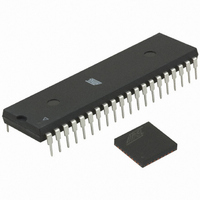ATMEGA64RZAV-10PU Atmel, ATMEGA64RZAV-10PU Datasheet - Page 61

ATMEGA64RZAV-10PU
Manufacturer Part Number
ATMEGA64RZAV-10PU
Description
MCU ATMEGA644/AT86RF230 40-DIP
Manufacturer
Atmel
Series
ATMEGAr
Datasheets
1.ATMEGA644-20MU.pdf
(23 pages)
2.ATMEGA644-20MU.pdf
(376 pages)
3.AT86RF230-ZU.pdf
(98 pages)
Specifications of ATMEGA64RZAV-10PU
Frequency
2.4GHz
Modulation Or Protocol
802.15.4 Zigbee
Power - Output
3dBm
Sensitivity
-101dBm
Voltage - Supply
1.8 V ~ 3.6 V
Data Interface
PCB, Surface Mount
Memory Size
64kB Flash, 2kB EEPROM, 4kB RAM
Antenna Connector
PCB, Surface Mount
Package / Case
40-DIP (0.600", 15.24mm)
Wireless Frequency
2.4 GHz
Interface Type
JTAG, SPI
Output Power
3 dBm
For Use With
ATSTK600-TQFP32 - STK600 SOCKET/ADAPTER 32-TQFPATAVRISP2 - PROGRAMMER AVR IN SYSTEMATSTK500 - PROGRAMMER AVR STARTER KIT
Lead Free Status / RoHS Status
Lead free / RoHS Compliant
Operating Temperature
-
Applications
-
Data Rate - Maximum
-
Current - Transmitting
-
Current - Receiving
-
Lead Free Status / Rohs Status
Lead free / RoHS Compliant
For Use With/related Products
ATmega64
- Current page: 61 of 376
- Download datasheet (8Mb)
11.1.2
11.1.3
2593N–AVR–07/10
EIMSK – External Interrupt Mask Register
EIFR – External Interrupt Flag Register
cleared by writing a logical one to its Interrupt Flag bit (INTFn) in the EIFR Register before the
interrupt is re-enabled.
Table 11-1.
Note:
Table 11-2.
• Bits 2:0 – INT2:0: External Interrupt Request 2 - 0 Enable
When an INT2:0 bit is written to one and the I-bit in the Status Register (SREG) is set (one), the
corresponding external pin interrupt is enabled. The Interrupt Sense Control bits in the External
Interrupt Control Register, EICRA, defines whether the external interrupt is activated on rising or
falling edge or level sensed. Activity on any of these pins will trigger an interrupt request even if
the pin is enabled as an output. This provides a way of generating a software interrupt.
• Bits 2:0 – INTF2:0: External Interrupt Flags 2 - 0
When an edge or logic change on the INT2:0 pin triggers an interrupt request, INTF2:0 becomes
set (one). If the I-bit in SREG and the corresponding interrupt enable bit, INT2:0 in EIMSK, are
set (one), the MCU will jump to the interrupt vector. The flag is cleared when the interrupt routine
is executed. Alternatively, the flag can be cleared by writing a logical one to it. These flags are
always cleared when INT2:0 are configured as level interrupt. Note that when entering sleep
mode with the INT2:0 interrupts disabled, the input buffers on these pins will be disabled. This
may cause a logic change in internal signals which will set the INTF2:0 flags. See
Enable and Sleep Modes” on page 69
Bit
0x1D (0x3D)
Read/Write
Initial Value
Bit
0x1C (0x3C)
Read/Write
Initial Value
ISCn1
Symbol
t
0
0
1
1
INT
1. n = 3, 2, 1or 0.
When changing the ISCn1/ISCn0 bits, the interrupt must be disabled by clearing its Interrupt
Enable bit in the EIMSK Register. Otherwise an interrupt can occur when the bits are changed.
ISCn0
Parameter
Minimum pulse width for asynchronous
external interrupt
0
1
0
1
Asynchronous External Interrupt Characteristics
Interrupt Sense Control
R/W
R
7
–
0
7
–
0
Description
The low level of INTn generates an interrupt request.
Any edge of INTn generates asynchronously an interrupt request.
The falling edge of INTn generates asynchronously an interrupt request.
The rising edge of INTn generates asynchronously an interrupt request.
R
R
6
–
0
6
–
0
R
R
5
–
0
5
–
0
for more information.
(1)
R
R
4
–
0
4
–
0
Condition
R
R
3
–
0
3
–
0
INTF2
INT2
R/W
R/W
2
0
2
0
Min
INTF1
INT1
R/W
R/W
1
0
1
0
ATmega644
Typ
50
INTF0
INT0
R/W
R/W
0
0
0
0
Max
”Digital Input
EIMSK
EIFR
Units
ns
61
Related parts for ATMEGA64RZAV-10PU
Image
Part Number
Description
Manufacturer
Datasheet
Request
R

Part Number:
Description:
DEV KIT FOR AVR/AVR32
Manufacturer:
Atmel
Datasheet:

Part Number:
Description:
INTERVAL AND WIPE/WASH WIPER CONTROL IC WITH DELAY
Manufacturer:
ATMEL Corporation
Datasheet:

Part Number:
Description:
Low-Voltage Voice-Switched IC for Hands-Free Operation
Manufacturer:
ATMEL Corporation
Datasheet:

Part Number:
Description:
MONOLITHIC INTEGRATED FEATUREPHONE CIRCUIT
Manufacturer:
ATMEL Corporation
Datasheet:

Part Number:
Description:
AM-FM Receiver IC U4255BM-M
Manufacturer:
ATMEL Corporation
Datasheet:

Part Number:
Description:
Monolithic Integrated Feature Phone Circuit
Manufacturer:
ATMEL Corporation
Datasheet:

Part Number:
Description:
Multistandard Video-IF and Quasi Parallel Sound Processing
Manufacturer:
ATMEL Corporation
Datasheet:

Part Number:
Description:
High-performance EE PLD
Manufacturer:
ATMEL Corporation
Datasheet:

Part Number:
Description:
8-bit Flash Microcontroller
Manufacturer:
ATMEL Corporation
Datasheet:

Part Number:
Description:
2-Wire Serial EEPROM
Manufacturer:
ATMEL Corporation
Datasheet:










